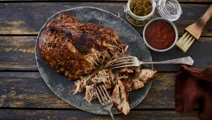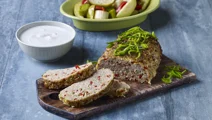Pâté

Like other French classics, pâté might be something many associates with classy cafés and restaurants serving it on a smorgasbord or toasted bread with tasty garnish. As such, it may not be a dish you have tried to make at home yet. However, with our easy pâté recipe, making this delicious spread from scratch is neither difficult nor time-consuming. Serve it hot or cold as a fancy starter with bread or use it to make decadent sandwiches.
Ingredients
Pâté:
|
4 slices
Crustless white bread
|
|
|---|---|
|
200 ml
Milk
|
|
|
½ kilo
Chopped pork livers
|
|
|
½ kilo
Ground pork (approx. 6% fat)
|
|
|
200 ml
Chopped fresh, curly leaf parsley
|
|
|
1
Finely chopped onion
|
|
|
1
Egg
|
|
|
¾ tsp
Grated nutmeg
|
|
|
2½ tsp
Coarse salt
|
|
|
Freshly churned pepper
|
Garnish:
|
Dried cranberries, perhaps marinated in a bit of orange juice
|
|
|---|---|
|
Walnuts
|
Instructions
Tips
The best French pâté, unless specifically described as rustic, has a smooth consistency. To ensure this, it is important to spend some time combining the ingredients well to make sure there a no lumps. A good way to do so is to get in there and use your fingers to combine the mixture as it is much easier to feel and assess the texture this way. Use nitrile or vinyl cooking gloves to prevent bacterial spreading or if you do not like touching raw meat.
Questions about pâté
A pork liver pâté is a delightful appetizer that is not too difficult to make from scratch with this easy recipe. Learn more about the French classic by reading our answers to the most frequently asked questions below.
What is pâté?
Pâté is a type of cooked, spreadable meat paste. In France, where the dish is originally from, it is typically served as a starter with bread. Though it is often made with different pork meats, it may also be made with seafood, and other types of meat like game, chicken, duck, pheasant, rabbit, and even with vegetables. Also, traditionally, it contains liver, but it can also be made with other parts of meat or, simply, vegetables like mushrooms.
How to make pâté?
Making pork liver pâté at home is not difficult, and since having a portion of the rich, spreadable paste waiting for you in the refrigerator or freezer is great, it is something you should try at least once. Prepare it by soaking the white bread slices in milk before combining them with ground pork, chopped pork liver, parsley, onion, and egg. Season with salt, pepper, and nutmeg, bake it and serve it with bread and your garnishes of choice either while it is still warm or after it has cooled.
Can you freeze pâté?
A liver pâté may be frozen for up to 3 months. To ensure the quality of its flavour and texture it is important to store the homemade spread in an airless environment. Use an ice cube tray or small silicone moulds to flash freeze it in your preferred portion sizes before wrapping them in a few layers of cling film and transferring them to airless freezer bags. When you are ready to eat the rest of the spread, thaw it overnight in the refrigerator or a bowl of warm water if you are in a hurry.
How long does pâté last?
Homemade pâtés do not have a long shelf life but may last for 5-10 days if stored correctly in the refrigerator. Make sure that it is tightly wrapped to ensure its taste and texture. The French classic may easily absorb the flavours of other foodstuffs in the refrigerator or freezer so wrapping it well is crucial.
Is pâté raw?
No, it is not raw. As such, all homemade pâté recipes will instruct you to cook the dish in some way as consuming raw pork meat and liver may lead to severe cases of food poisoning. Traditionally, it is baked in a terrine or loaf tin.
How to serve pâté as an appetizer?
As a starter, the French classic may be served either hot or cold with a baguette, toasted bread, or the like. It can be garnished with nuts, dried fruit, or fresh herbs and served with different sides like cornichons and Dijon mustard or a fruity compote for some complementary sweetness.
What is the difference between pâté and foie gras?
Though both pâté and foie gras are pastes of French origin, they are not necessarily made from the same kind of meat. While foie gras is always made using the fattened liver from either geese or ducks, pâtés may be made using a variety of different meat types or even vegetables. The former also tend to be even softer and creamier than the latter which has a thicker consistency.
Easy traditional French pâté
Pork pâté is a flavourful classic. The French name of the dish simply means 'paste' in English, and it describes the dish's smooth and buttery texture perfectly. The flavourful spread with minced pork, pork liver, and onion is incredibly rich and flavourful.
Garnished with nuts and dried cranberries for a bit of crunch and sweetness, this creamy French spread makes for a wonderful appetiser, sandwich filling, or addition to a well-stocked smorgasbord or charcuterie board with cheese and delicious cuts of meat.
Pork liver pâté
French pork pâté is a rich and decadent savoury treat. The richness that the pork liver gives the spread makes the addition of curly-leaf parsley perfect. The fresh herb brings a freshness to the dish that brightens and lightens it wonderfully.
The subtle nuttiness and woody flavour of the nutmeg pairs well with the pork and makes for a well-rounded eating experience. It also adds some sweetness that goes well with the mild pork, and it is beautifully balanced by the slightly tart cranberries and bitter walnuts served on top.
How to serve pâté the traditional way
In France, the spread is traditionally served as a starter on a baguette or toasted bread. Plated simply in thin slices on top of or next to the bread, pâté starter ideas include garnishing it with dried cranberries and walnuts, as we do in this recipe, or with fresh herbs or serving it with cornichons and Dijon mustard. Fruity additions like a compote or chutney made from figs, pears, blackberries, or red onion also go well with the spread and are, as such, quite popular. It is a genius hors d’oeuvres or finger food as it is filled with flavour and easily plated and served in a small bite size.
In case our recipe for this classic French spread has inspired you to put together an entire menu inspired by the renowned French cuisine, we suggest having a look at our recipe for coq au vin as your main course. For dessert, you could go for a smooth vanilla parfait, a sweet cherry clafoutis, or some delicate chocolate macarons.
Add your own touch
You can experiment with a simple pork liver pâté recipe in several ways. One option is to use additional aromatics like garlic or orange zest in addition to the onion and nutmeg. This layering of flavours will add depth to your homemade pâtés. Flavouring them with spices like dried thyme, bay leaf, or allspice is also a great option. This will add a herbaceous earthiness that works well with the rich meat.
Another popular choice in many traditional liver pâté recipes is to add a bit of whisky, cognac, or Armagnac. These spirits help underscore the smooth and rich flavour that pâtés are known and loved for.
If you would like the French classic to be on the saltier side, wrapping it in bacon before baking it is another popular option. Though this is a more untraditional choice, the crisp bacon adds a different texture that complements the creaminess of the spread well.








